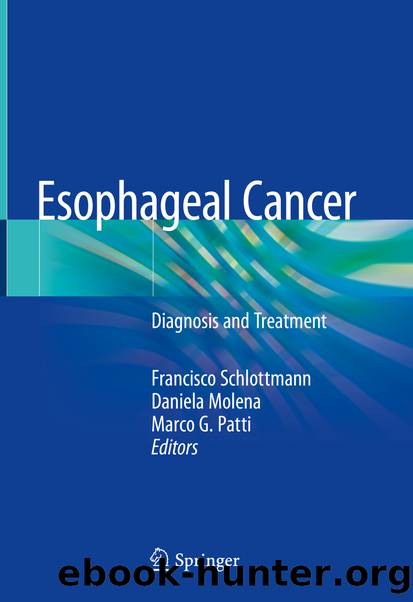Esophageal Cancer by Unknown

Author:Unknown
Language: eng
Format: epub
ISBN: 9783319918303
Publisher: Springer International Publishing
The esophagus is dissected away from the membranous part of the trachea until the left side of the cartilaginous trachea C-ring is reached. The trachea is rotated and retracted anteriorly and the esophagus is pulled posteriorly by the sling to expose the left tracheoesophageal groove. With blunt dissection, the left recurrent laryngeal nerve should be identified along the left side of the trachea. The sympathetic nerve runs in parallel to and sometimes mimics the left recurrent laryngeal nerve . The integrity and location of the nerve can be checked by nerve stimulator (Fig. 11.2). Extra care should be taken in subaortic lymph node dissection to prevent injury to the pulmonary artery, which is potentially lethal. The whole thoracic esophageal dissection is now completed. A Fr 24 chest drain is inserted towards the apex. The authors prefer a Fr 19 round fluted drain connected to vacuum drainage. This is much more comfortable and allows easy ambulation. A formal chest tube is only inserted when extensive adhesiolysis has been performed since air leak is more efficiently drained by a conventional chest tube with underwater seal. After confirming lungs expansion, ribs are approximated with suture. Muscle and skin are closed in layers.
Fig. 11.2Left recurrent laryngeal nerve lymphadenectomy . E Esophagus (retracted posteriorly), T Trachea (retracted anteriorly), L Left lung. White arrow: left recurrent laryngeal nerve (after lymphadenectomy). The integrity of the left recurrent laryngeal nerve is checked by the ball-tip intermittent nerve stimulator
Download
This site does not store any files on its server. We only index and link to content provided by other sites. Please contact the content providers to delete copyright contents if any and email us, we'll remove relevant links or contents immediately.
The DNA Book by DK(779)
The Spike by Mark Humphries;(771)
The End of Food Allergy by Kari Nadeau MD PhD & Sloan Barnett(689)
Extra Life by Steven Johnson(666)
Your Brain Is Always Listening by Dr. Daniel G. Amen(654)
How to Sleep by Rafael Pelayo(603)
Unlocking Eden: Revolutionize Your Health, Maximize Your Immunity, Restore Your Vitality by Belt Daniel & Horn Joe(596)
The Hashimoto's AIP Cookbook: Easy Recipes for Thyroid Healing on the Paleo Autoimmune Protocol by Emily Kyle MS RDN CLT HCP & Phil Kyle Chef(593)
The Hospital by Brian Alexander(590)
The Low-FODMAP IBS Solution Plan and Cookbook by Rachel Pauls(583)
The Covid Survival Guide: What the Virus Is, How to Avoid It, How to Survive It by Rowell David(566)
The Big Book of Baby Names by Marissa Charles(554)
Lymph & Longevity by Gerald Lemole(539)
Linda Goodman's Love Signs by Linda Goodman(522)
Better Living Through Neurochemistry - A guide to the optimization of serotonin, dopamine and the neurotransmitters that color your world by James Lee(516)
Thrivers by Michele Borba Ed. D(508)
The Miracle Pill by Peter Walker(504)
Stroke For Dummies by John R. Marler(492)
Immunity by Jenna Macciochi(487)
